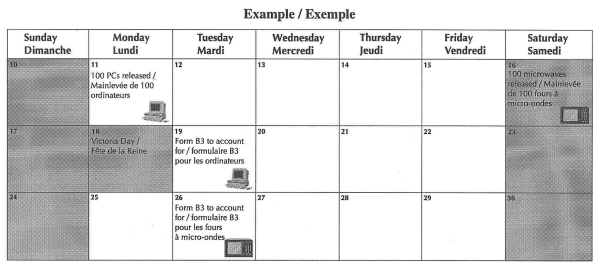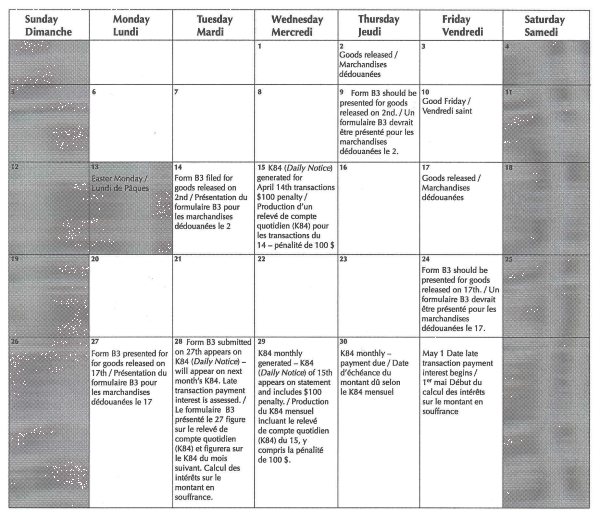| Français | Contact us | Help | Search | Canada Site |
| What's new | Site map | Publications and forms | Electronic services | Newsroom |
| Home | A - Z Index | |||
| Publications and forms > | ||||
This document is also available for download in other formats.
Memorandum D17-1-5
Ottawa, June 16, 2000
SECTION 3 - ACCOUNTING
TABLE OF CONTENTS
Back to the main TOC (Section 3 - Accounting)- General
- Hard Copy Entry Processing System (CCEPS)
- Customs Cash Entry Processing System (CCEPS)
- Electronic Accounting Information
- Virtual Customs Office (VCO)
- Time Limits
- Invoice/Billing Documents
- Corrections
- Penalties
- Cancellation or Waiver of Interest and Penalties
GENERAL
142. Customs needs information to verify the value, classification, country of origin, tariff treatment, and exchange rate on imported goods. This data, as well as a breakdown of the duties and taxes owing must be shown on Form B3,Canada Customs Coding Form. Most of this can be found on the invoice completed when the goods were purchased. It may be conveyed either on hard copy (paper) or electronically.
143. If the importer or broker has posted security with customs for release of goods prior to payment, the account security number must appear as the first five digits of the transaction number on all accounting documentation. The transaction number is a 14 digit number assigned by customs, which must be in bar code format. Information on the transaction number and coding instructions for this form are available in Memorandum D17-1-10, Coding of Customs Accounting Documents.
Note: Customs will apply the 14 digit bar-coded transaction number to accounting documents submitted by clients who do not have security.
HARD COPY ACCOUNTING DOCUMENTS
144. The hard copy (paper) accounting document must be given to the customs office of release. It may be either typed or handwritten. Copies of the form are available at CCRA offices, or it may be privately printed. Specifications are found in Memorandum D17-1-11, Private Printing Policy and Procedures. A copy of the form may also be obtained through the Virtual Customs Office. A sample is contained in Appendix 3A.
CUSTOMS CASH ENTRY PROCESSING SYSTEM (CCEPS)
145. CCEPS is a self-serve automated system for individuals or small businesses who import commercial goods. Clients can use CCEPS at a computer station in certain customs offices to complete Form B3. The system helps clients complete the form through a series of prompts, calculates applicable duties and taxes, and generates a printed accounting form. A list of offices that provide CCEPS is contained in Appendix 3B.
ELECTRONIC ACCOUNTING INFORMATION
Note: An importer or broker must have security for release prior to payment in order to transact business electronically with customs.
146. Accounting data may be transmitted from a company's office to the customs system using the Customs Automated Data Exchange (CADEX) system or a value-added network via the CUSDEC B3 Entry System. The "Accounting Office" record field must be the same office code as the "Release Office" on the electronic transmission. For more information on how to participate in electronic commerce accounting, contact the Manager, Electronic Commerce Unit.
VIRTUAL CUSTOMS OFFICE (VCO)
147. VCO is a CCRA Internet site that contains general information on importing and exporting, including tariff treatments, duty rates, an exchange rate converter, Customs Notices, and news releases. Other Internet sites that may support a company's customs operations can be accessed directly from the VCO Web site. The VCO also includes a printing facility that will print such forms as the Certificate of Origin and Form B3. VCO Web site is www.ccra-adrc.gc.ca/vco/
TIME LIMITS
148. Final accounting documentation for goods released on the basis of interim accounting documents must be presented to customs within a prescribed time limit.
149. Customs makes a distinction between "high value" and "low value" shipments for the purpose of establishing time limits for submitting this information.
High Value Shipments
150. High value shipments are goods valued at $1,600 or more. The calculation of the time limit for high value shipments is based on regular business days and does not include Saturdays, Sundays, and federal and provincial holidays.
151. Accounting information must be presented or transmitted and accepted by the customs automated system within five business days of the date customs releases the goods. When goods are released on a Saturday, Sunday, or holiday, the accounting period starts on the first business day after release. Importers or brokers have until one half hour before the end of the day shift, on the fifth day to submit their accounting data. If the data is transmitted electronically, CADEX must receive and validate the data prior to 8:00 p.m. E.S.T. on the fifth day.





